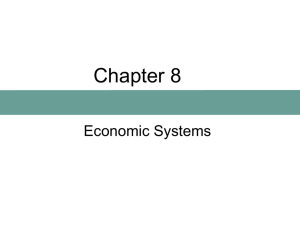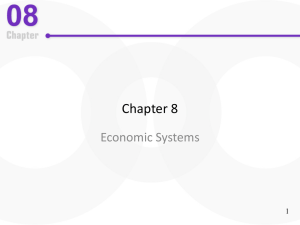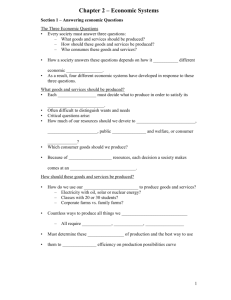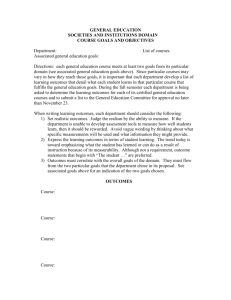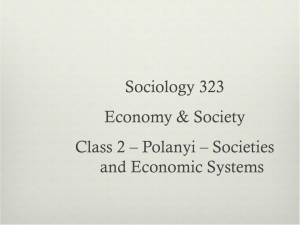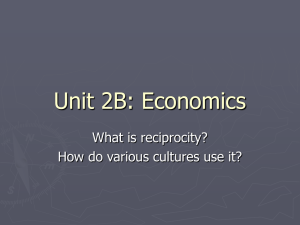0495810843_246881
advertisement
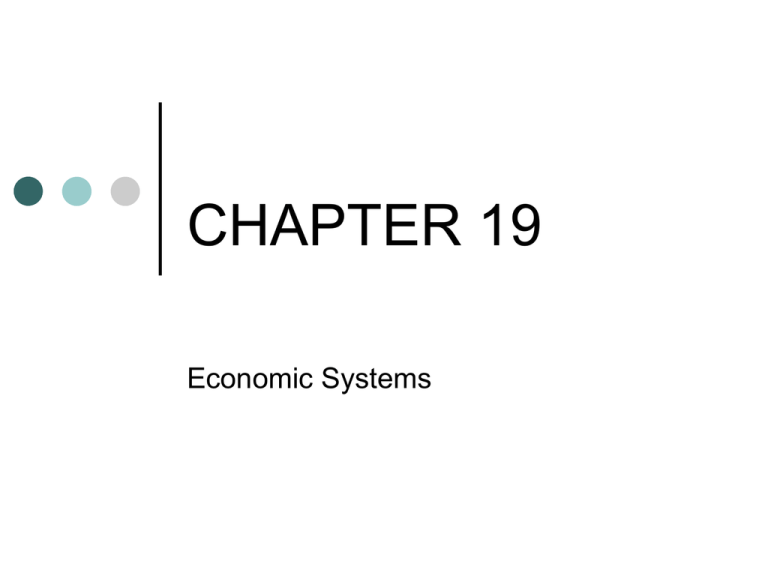
CHAPTER 19 Economic Systems Chapter Preview How Do Anthropologists Study Economic Systems? How Do Different Societies Organize Their Economic Resources and Labor? How and Why Are Goods Exchanged and Redistributed? Economic Systems Despite the complexity of the culture, all cultures have some form of an economic system because they all have some form of subsistence. All cultures have a means of producing, distributing, and consuming goods. The Yam Complex in Trobriand Culture Trobriand Island men devote a great deal of time and energy to raising yams, not for themselves but to give to others ( sisters and married daughters). The yams which switch hands from the women to their respective husbands is to show one’s respect for her husband. The more yams a man has in his yam house the higher his status because it shows he is well respected and liked. Control of Land & Water Resources The access to land and fresh water is naturally a resource all living people must obtain. Some societies have private ownership of these resources where as others divide them up among who has occupied that land the longest. We will examine all modes of subsistence by their control of land and water. Food Foraging Land is usually control by kinship groups rather than an individual. All bands will have their own “territory” an area they occupy that is considered theirs. Food foragers determine who will hunt game and gather plants in their home range and where these activities take place. Food Producing Pastoralists require a system that determines rights to watering places and grazing land for their animals. Often land will be divided up based on watering holes. Farmers (agricultural) must have some means of determining title to land and access to water for irrigation. Small scale farmers generally “own” land on lease and must pay tribute to the chief of the tribe who is said to own the land. Industrial In Western capitalist societies, private ownership of land and rights to natural resources generally prevails. This is also based on the individual not the group as it might be for foraging and some producing societies. Technology Resources Similar to economic systems all societies will have some form of technology which is best described as tools and other material equipment, together with the knowledge of how to make and use them. Technology complexity can vary among groups but one thing is important technological advances are relative to the society in which they are found. Technology Food foragers and patoralists who are nomadic have fewer and simpler tools than sedentary farmers. In fact the average member of the Ju/’hoansi owns about 25lbs of possessions per member! The primary tools for horticulturists include the axe, digging stick, and hoe. Division of of Labor Despite variations of labor patterns cross culturally it can be said that every society has a division of labor by gender and age at the very minimum. There are three documented patterns of labor by gender: Flexible/integrated pattern Segregated pattern Dual sex Configuration Flexible/Integrated Pattern Seen most frequently among food foragers. 35% of tasks are performed equally by men and women. Tasks considered appropriate for one gender may be performed by the other without the loss of face. Boys and girls grow up in much the same way and learn to value cooperation over competition. Segregated Pattern Common to pastoral, intensive agricultural, and industrial societies. Almost all work is defined as masculine or feminine. Men and women rarely engage in joint efforts and do not help one another. Both boys and girls are raised primarily by women. After puberty boys will spend most time with adult men and girls with adult women. Dual Sex Configuration Seen among some Native American tribes. Men and women carry out their work separately. The relationship is one of balanced complimentarily rather than inequality. Each gender manages its own affairs, and the interests of both men and women are represented at all levels. Division of Labor by Age Typical to have a division by age in all societies although it varies greatly. Food foraging societies such as the Ju/’hoansi do not expect children to contribute to subsistence until their late teens. Elders will also “retire” around the age of 60. In some farming communities both children and elders are expected to contribute to the group or household. Girls among the Mayan peasant groups may begin to do housework and watch younger children around the age of 7 or 8 years old. Industrial societies may also find younger children and elders working in factories to help support their families. Reciprocity There are three main forms of reciprocity which one mode of distribution. Generalized - The value of what is given is not calculated and repayment is not specified. Balanced -A direct obligation to reciprocate in equal value for the relationship to continue. Negative - The giver tries to get the better of the deal. What do you see most in your culture? The Kula Ring Form of Balanced Reciprocity The ceremonial trading of shell necklaces and armbands in the Kula ring encourages trade throughout Melanesia. Barter Bartering occurs when two or more partners from different groups negotiate a direct exchange of one trade good for another. Often this transaction can turn hostile of both parties are not in agreement- thus similar to negative reciprocity. As each party seeks to get the best possible deal, both may negotiate until a balance has been reached where each feels satisfied at having achieved the better of the deal. Trade Silent trade or bartering with no verbal communication may be common due to a lack of a common language between neighboring groups. Allows for the maintenance of solidarity between allies and the building of such allies. Redistribution Redistribution is the form of exchange in which goods flow into a central place where they are sorted, counted, and reallocated. Redistribution involves a certain amount of power and control. In societies with a surplus to support some sort of government, goods in the form of gifts, tribute, taxes, and the spoils of war are gathered into storehouses controlled by a chief or some other type of leader. From there, they are handed out again. Motives in Redistributing Income The leadership by the chief or person in charge of redistribution has three motives in redistribution: 1. Gain or maintain a position of superiority through a display of wealth and generosity. 2. Assure those who support the leadership an adequate standard of living by providing them with desired goods. 3. Establish alliances with leaders of other groups by hosting them at lavish parties and giving them valuable goods. Gaining Status & Prestige Conspicuous consumption- a term coined by Thorstein Veblen to describe the display of wealth for social prestige. This is a way to gain social status without actually distributing anything. Potlatches on the other hand are a form of conspicuous consumption where a village chief will give away his goods (food) to his people in a showy displace of his wealth. Gaining Status & Prestige Potlatches often compel others in the society to also give away goods by hosting a public feast so that no one person accumulates more wealth than another. These are called leveling mechanisms. One last method of gaining status and prestige is prestige economy. The main difference between this and conspicuous consumption is that mass wealth is obtained for the purpose of giving it away to others. Market Exchange Buying and selling of goods and services, with prices set by rules of supply and demand is known as Market Exchange. Prices are set on the basis of supply and demand. Often money may be used although it is not necessary as in some non-industrial societies. Other goods may be used for barter/ trade. Money is defined as something used to make payments for goods and services as well as to measure their value. The wide range of things that have been used as money in one or another society includes salt, shells, stones, beads, feathers, fur, bones, and teeth. Informal Economy (Black Market) The production of marketable commodities that for various reasons escape enumeration, regulation, or any other sort of public monitoring or auditing. Examples of goods or services that may be obtained on this type of market: Child care, house cleaning, gardening, alcohol, drugs, prostitution, illegal labor, gambling, etc.




